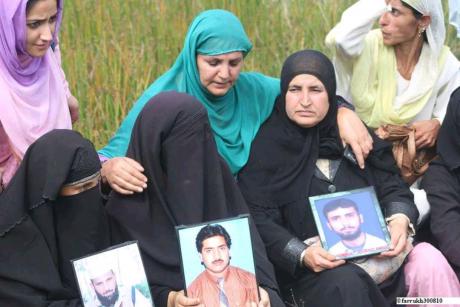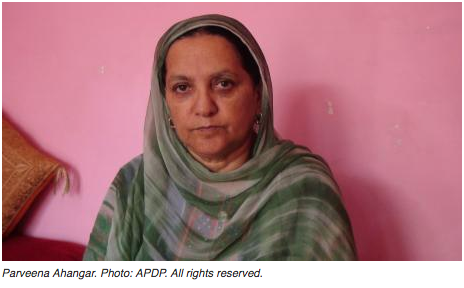opendemocracy – Thousands of young men have ‘disappeared’ in Kashmir and there have been numerous allegations of sexual assaults. But the fight for answers and justice continues.
This year, India and Pakistan celebrated 70 years of freedom from British imperialism. But the horrors of partition – dividing the subcontinent, creating the new country of Pakistan – have not been forgotten. More than a million people were killed and several million displaced.
In Kashmir, a still-contested border region, residents continue to cry out for azadi, or freedom. The Indian-administered valley remains one of the most militarised areas in the world, with as many as 700,000 armed and paramilitary forces stationed here. Human rights groups have repeatedly condemned extrajudicial killings by Indian forces.
According to the Association of Parents of Disappeared Persons (APDP), between 1989 and 2006, up to 10,000 people were ‘disappeared’ in Kashmir. Many were abducted and held in custody by Indian forces, and never seen again. There have been numerous allegations of sexual assaults as well.
Gazala Peer grew up in Kashmir. Now a lawyer who has worked with the APDP, she told me that such abuses have been enabled by laws like the Armed Forces Special Powers Act (AFSPA). An extension of a British colonial ordinance, it lets the army enter any premises at any time, without a search warrant, and use lethal force and ‘shoot to kill.’
Peer said this act has been used to “terrorise” the population and that the state has employed a range of strategies to shirk responsibility for abuses.
An emphasis on forensic evidence, for instance, has been used to challenge women’s allegations of rapes by the Indian army, and limit their access to justice, she says. Meanwhile, for the disappeared, modern forensics may help identify corpses, but what about their abductions, detentions, possible tortures, and those responsible?
A mother’s quest for justice
Disappearances in Kashmir appear to have declined sharply since 2006, amid increased campaigning by groups like APDP, and the election of a new chief minister for the northern Indian state of Jammu and Kashmir, who specifically instructed security services to avoid human rights violations.
But the work of unearthing the truth about what happened to the disappeared continues. It is believed that many cases ended in extrajudicial killings or deaths by torture. In 2011, special investigators from the Jammu and Kashmir Human Rights Commission found more than 2,000 corpses buried in unmarked graves.
A majority of Kashmir’s disappeared are young men, including minors. Parveena Ahangar told me that in 1991, her then 17-year old son Javaid was abducted by armed officers, and never heard from again. Searching for him, over the years she met other parents on similar quests.
In 1994, Ahangar filed a habeas corpus petition in Jammu and Kashmir’s High Court, demanding that the state produce evidence of what happened to her son after he was picked up by the army.
That same year, she founded the APDP, supported by other human rights activists and lawyers in Kashmir, to organise efforts to seek justice and information on the whereabouts of missing family members. It presently consists of the relatives of about 1,000 people.
This year, Ahangar won the 2017 Rafto human rights prize in recognition of her decades of campaigning.
Over the last 25 years, thousands of habeas corpus petitions have been filed in quests to locate the disappeared. But there are still disputes about basic facts. The government has admitted that nearly 4,000 people are missing in Kashmir, but claims that some may have crossed into Pakistan to join militant groups.
Peer says such claims are a way for the state to shirk responsibility for abductions, torture and extrajudicial killings. Another state strategy, she says, is encouraging families to file missing persons reports which, by definition, exonerate abductors of wrongdoing.
The police have ‘solved’ just four disappearances: each of which appear to have ended in premeditated murders, staged to look like deaths in crossfire, or as the result of self-defence by the police.
And then there are the numerous allegations of sexual assaults committed by the Indian army. Police stations across Kashmir are filled with missing persons reports, but not the paperwork required to set the criminal process in motion in sexual violence cases.
Peer told me that even when women report such assaults to the police, officers may simply refuse to fill out the requisite paperwork. Reports that are filed, may not be investigated. Forensic samples may not be collected on time. Samples or results may be mishandled.
In one case in February 1991, at least 100 women were allegedly raped by Indian army soldiers in the villages of Kunan and Poshpora. The state denied the assaults altogether. No forensic evidence was collected. The official investigation was over before it began.
More recently, in 2009 two women were raped and murdered in the district of Shopian. Their bodies were found a day after they went missing, but were not sent for autopsies. Paramilitary forces appear to have pressured the families to bury them immediately.
This case sparked mass protests in Kashmir that lasted for several months. Amid this pressure, police exhumed the bodies and sent them for autopsies. The official report said their hymens were intact, ruling out rape. But it also cited drowning in a nearby stream as their cause of death, even though the water level was only ankle-deep.
For a brief moment, there was hope that forensic evidence could reveal the truth and enable access to justice for human rights abuses. Instead, many who followed this case concluded that forensics will always be used by the state to suit its own purposes.
Remembering the disappeared
For the disappeared, DNA tests can determine the identity of individuals buried in unmarked graves. For APDP this is an important step, but it is not enough.
Peer describes a larger quest for justice and accountability, which requires fully uncovering the fate of victims, the circumstances of their abductions, detentions and deaths. In this struggle, remembering the disappeared is a collective, political act.
On the 10th of every month, in a public park in Kashmir’s capital Srinagar, APDP members share their own stories, and display court and police documents containing contradictions and statements they say have been manipulated.
They present their own facts, identifying army officers who abducted their relatives, and interrogation centres their kin were taken to. They relay denials from army officers, police officials and state bureaucrats.
In Argentina, mothers of those disappeared during the 1970s and 1980s have vigorously opposed the presumption that their loved ones are dead. Sociologist Avery Gordon has noted that “death exists in the past tense, disappearance in the present.”
Across Kashmir, ‘martyr graveyards,’ memorials at the sites of individual killings, and the commemoration of killings as sacrifices, are seen as part of a process of bearing witness to the oppression. There are also sports tournaments named after martyrs.
Women are prominent in the struggle for justice for the disappeared as they are in many other areas of the public sphere in Kashmir, where ongoing conflict has obliged many to take on the traditionally male role of breadwinner.
Tradition-based objections to women’s role in the public sphere cannot be sustained in this context. It would be premature, however, to declare this a victory for gender equality.
In his book Curfewed Night: A Frontline Memoir, journalist and writer Basharat Peer describes how mothers of the disappeared in Kashmir will lay an extra place for dinner every night. After dinner, the uneaten food from this extra plate is thrown away.
Night after night, this has became a ritual, a way of not forgetting lost sons. Such rituals will likely continue as long as answers and justice remain elusive, and the disappeared will continue to haunt Kashmiri life.



